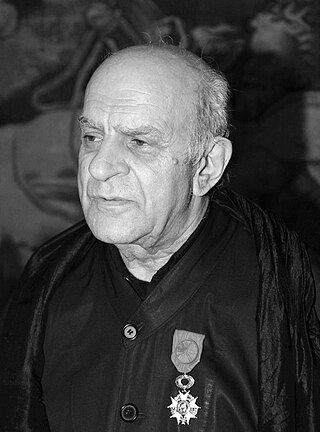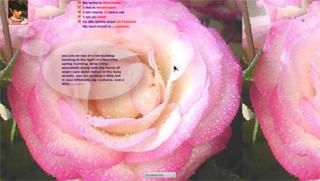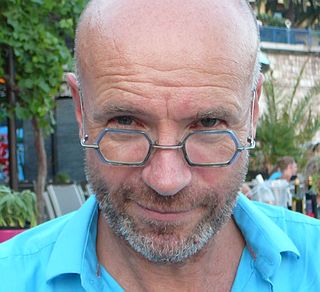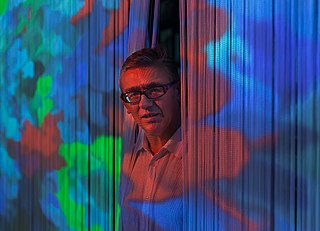
Electronic art is a form of art that makes use of electronic media. More broadly, it refers to technology and/or electronic media. It is related to information art, new media art, video art, digital art, interactive art, internet art, and electronic music. It is considered an outgrowth of conceptual art and systems art.

Joseph Nechvatal is an American post-conceptual digital artist and art theoretician who creates computer-assisted paintings and computer animations, often using custom computer viruses.

Maurice Benayoun is a French new-media artist, curator, and theorist based in Paris and Hong Kong.

Alekos Fassianos was a renowned Greek painter. He gained recognition for his distinctive style, which was characterized by immediacy and a deliberate departure from standardized painting techniques.

Oliver Grau is a German art historian and media theoretician with a focus on image science, modernity and media art as well as culture of the 19th century and Italian art of the Renaissance. Main Areas of Research are: Digital Art, Media Art History, immersion, digital humanities, documentation and conservation strategies of born-digital media art. He is founder and director of the Archive for Digital Art (1998) and founder and head of the Society for MediaArtHistories and its biennial conference series. His monograph "Virtual Art: From Illusion to Immersion" is highly cited and with translations of his texts in 15 languages to date and over 300 invited lectures in 44 countries, he is one of the most internationally renowned contemporary art and media scholars.

Mouchette.org is an interactive website created in 1996 by a pseudonymous character, an Amsterdam-based artist who calls herself "Mouchette." With her innocent salutation and claims to be "nearly thirteen" greeting the visitor from the introduction page, what initially appears as a personal website of an underage female artist evolves into darker themes in the subsequent pages.

Dominique Moulon is a historian of art and technology, art critic and curator, specializing in French digital art. He is the author of the books Art contemporain nouveaux médias and Art Beyond Digital.

Patrick Moya is a Southern French artist. He lives in Nice on the French Riviera. Moya has been at the forefront since the 1970's in straddling the latest forms of media and technology. He is an early pioneer of video art in the metaverse, working on Second Life since July 2007.
Edmond Couchot was a French digital artist and art theoretician who taught at the University Paris VIII.

New media art includes artworks designed and produced by means of electronic media technologies. It comprises virtual art, computer graphics, computer animation, digital art, interactive art, sound art, Internet art, video games, robotics, 3D printing, immersive installation and cyborg art. The term defines itself by the thereby created artwork, which differentiates itself from that deriving from conventional visual arts such as architecture, painting or sculpture.
Jacques Perconte is a French Filmmaker and new media artist born 1974 and living in Paris. His last artwork After the fire travelled all over the world. Since 1999 his films and new media projects explore the digital medium. He started to use video compression artifacts as the centre of his technic in 2002.

Ricardo Mbarkho, is a Lebanese contemporary artist, researcher, and assistant professor.

Isabelle Arvers is a French media art curator, critic, and author specializing in video and computer games, web animation, digital cinema, retrogaming, chiptunes, and machinima. Born in Paris in 1972, she currently lives in Marseille. She has curated exhibitions in France and internationally, exploring the relationship between art, video and computer games, and politics. Additionally, she promotes free and open-source culture, as well as indie games and art games.

Miguel Chevalier is a French digital and virtual artist. Since 1978, Miguel Chevalier has used computers as a means of expression in the field of the visual arts. He has established himself internationally as one of the pioneers of virtual and digital art.
Olivier Auber is a French independent artist and researcher. He is best known for his project "Poietic Generator" and for having introduced the concept of "Digital Perspective" in the fields of network theory, art, and digital humanities.
Grégory Lasserre & Anaïs met den Ancxt are also known under their artist name Scenocosme.

Hervé Fischer is a French artist-philosopher and sociologist. He graduated from the École Normale Supérieure and defended his Master's thesis on Spinoza's political philosophy with Raymond Aron and devoted his main research to the sociology of colour. For many years he taught the sociology of communication and culture at the Sorbonne, where he was promoted to master lecturer in 1981. At the same time, he developed a career as a multi-media artist and creator of "sociological art" (1971) and initiated many public participation projects with radio, television, and print media in many European and Latin American countries before coming to Quebec. He speaks fluently French, English, German and Spanish.
Kim Timby is a photography historian based in Paris who teaches at the École du Louvre and works as a curator for a private collection specialising in international nineteenth-century photography. From her research and teaching, Timby writes on the cultural history of photography as a technology.
Chun Hua Catherine Dong (she/they) is a Chinese-born Canadian multimedia artist. Dong’s artistic practice is based in performance art, photography, video, installation, virtuality (VR), augmented reality (AR), and 3D printing within the contemporary context of global feminism.
Martine Neddam is a visual artist, research scientist and professor. She is a native of France and lives and works in Amsterdam. She teaches at the Gerrit Rietveld Academy and the University of Quebec in Montreal (UQAM)













